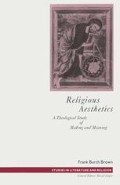Abstract
Just as most societies throughout history have managed to produce and appreciate artistic and aesthetic things without any concepts closely corresponding to our modern ideas of fine art and aesthetic experience, so have they managed to practise religion without making use of the equally modern idea of religion as such — that is, the idea of religion as a general phenomenon that takes particular forms. Religion in this sense is, as recent writers have stressed, a ‘child of the Enlightenment’ conceived in the scholar’s study.1 Moreover, religion so conceived is not itself the object of devotion and faith. When following a particular religious path, even the self-consciously religious person is not seeking some sort of generic religious experience any more than a connoisseur looking at Donatello’s David is in search of aesthetic experience in general.
Access this chapter
Tax calculation will be finalised at checkout
Purchases are for personal use only
Preview
Unable to display preview. Download preview PDF.
Notes
Jonathan Z. Smith, Imagining Religion (Chicago: University of Chicago Press, 1982) pp. xi, 104.
See Wilfred Cantwell Smith, The Meaning and End of Religion (New York: New American Library, 1962).
Cf. Joachim Wach, Types of Religious Experience: Christian and Non-Christian (Chicago: University of Chicago Press, 1951) pp. 32–3.
Clifford Geertz, ‘Religion As a Cultural System’, in The Interpretation of Cultures (New York: Basic Books, 1973) p. 90.
See Donna Marie Wulff, ‘On Practicing Religiously: Music as Sacred in India’, in Joyce Irwin, ed., Sacred Sound: Music in Religious Thought and Practice, JAAR Thematic Studies 50:1 (Chico, Calif.: Scholars Press, 1983).
See Diana L. Eck, Darsan: Seeing the Divine Image in India (Chambers-burg, Penn.: Anima, 1981).
Samuel Laeuchli, Religion and Art in Conflict (Philadelphia: Fortress, 1980) p. 7.
See F. David Martin’s otherwise valuable study Art and the Religious Experience: The ‘Language’ of the Sacred (Lewisburg, Penn.: Bucknell University Press, 1972).
An analogous weakness mars Geddes MacGregor’s book Aesthetic Experience in Religion (London: Macmillan, 1947),
Théophile Gautier, ‘Fanny Elssler’ in “La Tempete”, in Roger Copeland and Marshall Cohen, eds, What is Dance?: Readings in Theory and Criticism (Oxford: Oxford University Press, 1983) p. 431.
From John of Salisbury, Polieratus (1159), quoted in Piero Weiss and Richard Taruskin, eds, Music in the Western World: A History in Documents (New York: Schirmer, 1984) p. 62.
Cf. documents from the Council of Trent (1545-1563), in Robert F. Hayburn, Papal Legislation on Sacred Music (Collegeville, Minn.: Liturgical Press, 1979).
Matthew Fox, Breakthrough: Meister Eckhart’s Creation Spirituality in New Translation (Garden City, NY: Doubleday-Image, 1980) p. 169.
See Mark C. Taylor, Erring: A Postmodern A/theology (Chicago: University of Chicago Press, 1984);
and Charles E. Winquist, Epiphanies of Darkness: Deconstruction in Theology (Philadelphia: Fortress, 1986).
See John Dominic Crossan, Cliffs of Fall: Paradox and Polyvalence in the Parables of Jesus (New York: Crossroad-Seabury, 1980).
See Barbara Kiefer Lewalski, Protestant Poetics and the Seventeenth-Century Religious Lyric (Princeton, NJ: Princeton University Press, 1979).
See ibid.; and Terrence Erdt, Jonathan Edwards: Art and the Sense of the Heart (Amherst: University of Massachusetts Press, 1980) pp. 63–77.
See Stanley E. Fish, Self-Consuming Artifacts: The Experience of Seventeenth-Century Literature (Berkeley: University of California Press, 1972).
Quoted in C. John Sommerville, ‘The Religious Music of the Twentieth and Twenty-First Centuries’, Religion (July 1984) 14: 245–67.
Quoted in Friedrich Blume, ed., Protestant Church Music (New York: Norton, 1975) p. 10.
Quoted in Jaroslav Pelikan, The Christian Tradition, vol. 2: The Spirit of Eastern Christendom (600–1700) (Chicago: University of Chicago Press, 1974) p. 122.
On the principle of sacramentality see Richard P. McBrien, Catholicism (Minneapolis: Winston, 1981).
See Otto G. von Simson, Sacred Fortress: Byzantine Art and Statecraft in Ravenna, 1948; reprint edn (Princeton, NJ: Princeton University Press, 1987); and Pelikan, Eastern Christendom, pp. 91–145.
See Wyatt Tee Walker, ‘Somebody’s Calling My Name’: Black Sacred Music and Social Change (Valley Forge, Penn.: Judson, 1979) p. 23.
See James H. Cone, The Spirituals and the Blues (New York: Seabury, 1972) pp. 40–1.
Quoted in Heinrich Bornkamm, Luther’s World of Thought, trans. Martin H. Bertram (Saint Louis: Concordia, 1958) p. 189.
Quoted in W. H. Gardner, Gerard Manley Hopkins, vol. 2 (London: Secker & Warburg, 1949) p. 230.
Edward W. Said, The World, the Text, and the Critic (Cambridge, Mass.: Harvard University Press, 1983) p. 290.
Thomas R. Martland, Religion As Art: An Interpretation (Albany: State University of New York Press, 1981) pp. 162, 124, 123.
Copyright information
© 1990 Frank Burch Brown
About this chapter
Cite this chapter
Brown, F.B. (1990). Varieties of Religious Aesthetic Experience. In: Religious Aesthetics. Macmillan Studies in Literature and Religion. Palgrave Macmillan, London. https://doi.org/10.1007/978-1-349-10021-7_5
Download citation
DOI: https://doi.org/10.1007/978-1-349-10021-7_5
Publisher Name: Palgrave Macmillan, London
Print ISBN: 978-1-349-10023-1
Online ISBN: 978-1-349-10021-7
eBook Packages: Palgrave Religion & Philosophy CollectionPhilosophy and Religion (R0)

